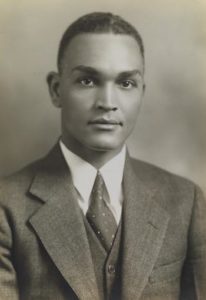
William Claytor
William Claytor was born on this date in 1908. He was a Black mathematician and educator.
Born in Norfolk, Virginia, William Waldron Schiefflin Claytor earned his A.B. and M.A. from Howard University. He went on to earn his Ph.D. from the University of Pennsylvania in 1933. Claytor was a brilliant student. While at Penn, he won a Harrison Scholarship in Mathematics in his second year and took the most prestigious award offered at Penn then, a Harrison Fellowship in Mathematics, in his third and final year of graduate studies.
Claytor's dissertation delighted the Penn faculty, providing a significant advance in the theory of Peano continua-—a branch of point-set topology. He was the third African American to earn a Ph.D. in mathematics, following Elbert Cox (Ph.D., Cornell, 1925) and Dudley Woodard, Sr. (Ph.D., University of Pennsylvania, 1928).
Upon completing the Ph.D., Claytor accepted a teaching position at West Virginia State College, where he remained for three years. In 1937, Claytor was awarded a Rosenwald Fellowship and pursued post-doctoral studies at the University of Michigan, where he had great promise as a researcher in mathematics. When a position opened, however, the University of Michigan would not offer it to him, apparently afraid of the possible reaction. The student newspaper took up the issue but to no avail.
The mathematician Kline tried to get Dr. Claytor to make a Fellow at Princeton University, but Princeton's administration said the students might object to a "culud" person. Claytor got the same reaction from other research institutions, which meant he could not get a position with other topologists during his time, which was a serious drawback to his work. After encountering this prejudice and leaving Michigan, Claytor lost research interest.
In the 1930s and 1940s, math was filled with racist mathematicians. R.L. Moore was one of the dominant figures in the same field of mathematics as Claytor's--Topology. Moore was so racist that, even in the 1960s and 70s, he prohibited blacks from attending his classes. During World War II, Claytor served in the U.S. Army (1941-1945), where he taught in the field of Anti-Aircraft Artillery from December 1942 through December 1944.
Dr. Claytor did make presentations at meetings of the American Mathematical Society yet was never allowed to stay in the hotel where the meetings were held. Instead, local Blacks had to find him lodging. For years afterward, many tried to get Claytor to participate in meetings of the American Mathematics Society, but he had grown bitter and refused.
1941, Claytor first met David Blackwell at Chanute Field, near Urbana, Illinois. Blackwell was increasingly aware of the immensity of Claytor's mathematical genius. In 1947, when Blackwell became chairman of the Mathematics Department at Howard University, Claytor was brought to Howard.
Soon after, Claytor met and married Dr. Mae Pullins, a lover of mathematics, though her Ph.D. was in psychology. Claytor remained at Howard until his retirement in 1965.
With 18 to 21 teaching hours per week and, later, as chair of the Department of Mathematics at Howard University, Dr. Claytor worked for years as a researcher but published only two papers: Topological Immersion of Peanian Continua in a Spherical surface, in the Annals of Mathematics 35 (1934), 809-835, and Peanian Continua Not Embeddable in a Spherical Surface, Annals of Mathematics 38 (1937), 631-636.
William Claytor died in 1967. In 1980, the National Association of Mathematicians instituted the Claytor Lecture, a lecture series in honor of William W. Schieffelin Claytor.